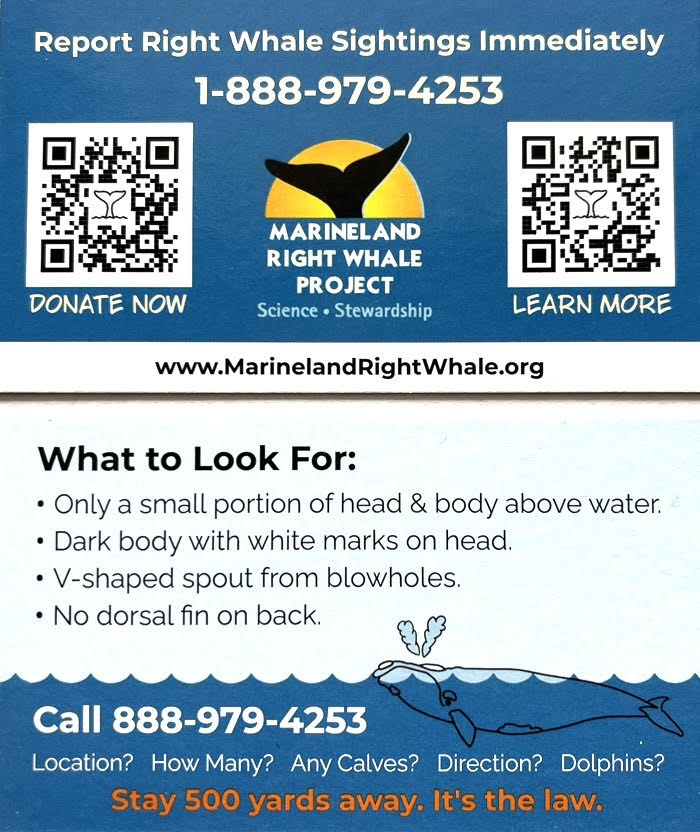Calves 8 and 9
There have been no new right whale sightings nearshore in our survey area since our last newsletter. There have, however, been some interesting sightings elsewhere. For starters, we are now up from 7 to 9 calves this season.
The 8th mother, Accordion, #4150, was first sighted with a calf by NOAA on February 3 off Sandy Hook, NY, far north of the traditional calving grounds. We don’t know whether the calf was born that far north, or if the pair evaded detection earlier in the southeast. Accordion is estimated to be between 14 and 17 years old and this is her first known calf.
Calf number 9 was spotted by FWC on February 5 just south of Amelia Island, FL. The mother, Cashew, #4292, is 23 years old and this is her 3rd known calf. She is named for her biggest callosity, which looks like a curved cashew nut.
Koala and Curlew’s Big Adventure
The other exciting news concerns the two adult females, Koala and Curlew, who have been traveling together since late November. The last time they were seen off the east coast of Florida was on January 13, heading south toward Boca Raton. Several weeks went by with no new sightings, until they popped up on February 2 in an unusual location--near Mobile, Alabama! That day they were first sighted near Perido Pass, which seems fitting since “perdido” means “lost” in Spanish.
Only a handful of right whales have been known to venture into the Gulf. Between 2004 and 2020, three first-time mothers took their calves there (2004, Derecha; 2006, Boomerang; and 2020, Snow Cone). Each mother-calf pair eventually exited the Gulf and headed north as expected.
Koala and Curlew are the first pair of adult right whales recorded in the Gulf. They created quite a splash and garnered lots of media attention including an article by Dinah Pulver in USA Today, featuring images by our colleague Joel Cohen of BWRI. By February 8, public reports showed that they had started moving eastward. They were last seen on February 11 off Port Saint Joe, heading south. When and where will this traveling pair show up next?
Sightings of Koala and Curlew, Nov 24 to Feb 2 (yellow) and Feb 8 to Feb 11 (pink).
(Based on preliminary data collected by CMARI, GDNR, FWC, MRWP, BWRI, and NOAA Fisheries)
Other Marine Animal Sightings
Over the past few weeks there have been several sightings of humpback whales. Around the beginning of February, our colleagues at BWRI sighted multiple humpback whales over 3 days off Melbourne Beach and Sebastian Inlet. On February 12 there was a humpback breaching repeatedly off north Flagler Beach.
Be aware that at this time of year manta rays return to the waters along the east coast of Florida. These large black and white rays have two fins that sometimes protrude from the water, so they are easily mistaken for dolphins. They can also be mistaken for larger whales, since they create large splashes when they breach. If something like this catches your eye, watch for additional cues such as a blow or a fluke to help determine if it is a whale or a manta ray.
Technology-Focused Mid-Season Meeting
On Saturday, February 8, about 110 volunteers gathered at the Whitney Lab for social hour, delicious potluck lunch, and presentations. Sara gave updates on the calving season to date. She premiered two videos of sightings Koala & Curlew and Check Mark & calf. These videos were shot and edited by volunteer drone pilot Jeff Greene and are now available on the Marineland Right Whale Project’s YouTube channel.
Sara then discussed some emerging technologies to detect and conserve right whales, including satellite imaging, acoustic monitoring, and rope-on-demand fishing. Sector 1S Team Leader Mike Alyea described how he and Cindy Alyea recently provided support to an acoustic monitoring project. They provided a boat and services to recover, and later redeploy, a Slocum glider outfitted with a passive acoustic monitoring package. The research project, led by Erin Meyer-Gutbrod (University of South Carolina) and Catherine Edwards (Skidaway Institute of Oceanography), is testing the feasibility of using gliders to autonomously listen for and record right whale vocalizations in the shallow coastal waters of the southeast U.S. (This news piece on All Things Considered summarizes the project nicely.)
Team photo after a successful recovery of a Slocum glider off Saint Augustine, FL, Jan 29, 2025. Image: Mike Alyea
Sector 4 volunteers Zoe Rauscher and her mother Laura Rauscher took turns presenting some innovations that they designed for our program: new sightings cards and a modern website. In addition to providing the whale hotline number and right whale characteristics, the cards include two QR codes: one pointing to an online donation page, the other to our sleek and informative website MarinelandRightWhale.org. Check out the website when you get a chance!
Mark Your Calendars
Saturday, March 8: Last official survey.
Saturday, March 15, 1:30-4:00pm: Season wrap-up meeting at the Whitney Lab.
In the meantime, let’s hope for good sighting conditions and more right whales in our survey area.
Flippers crossed!
Sara and Jim







